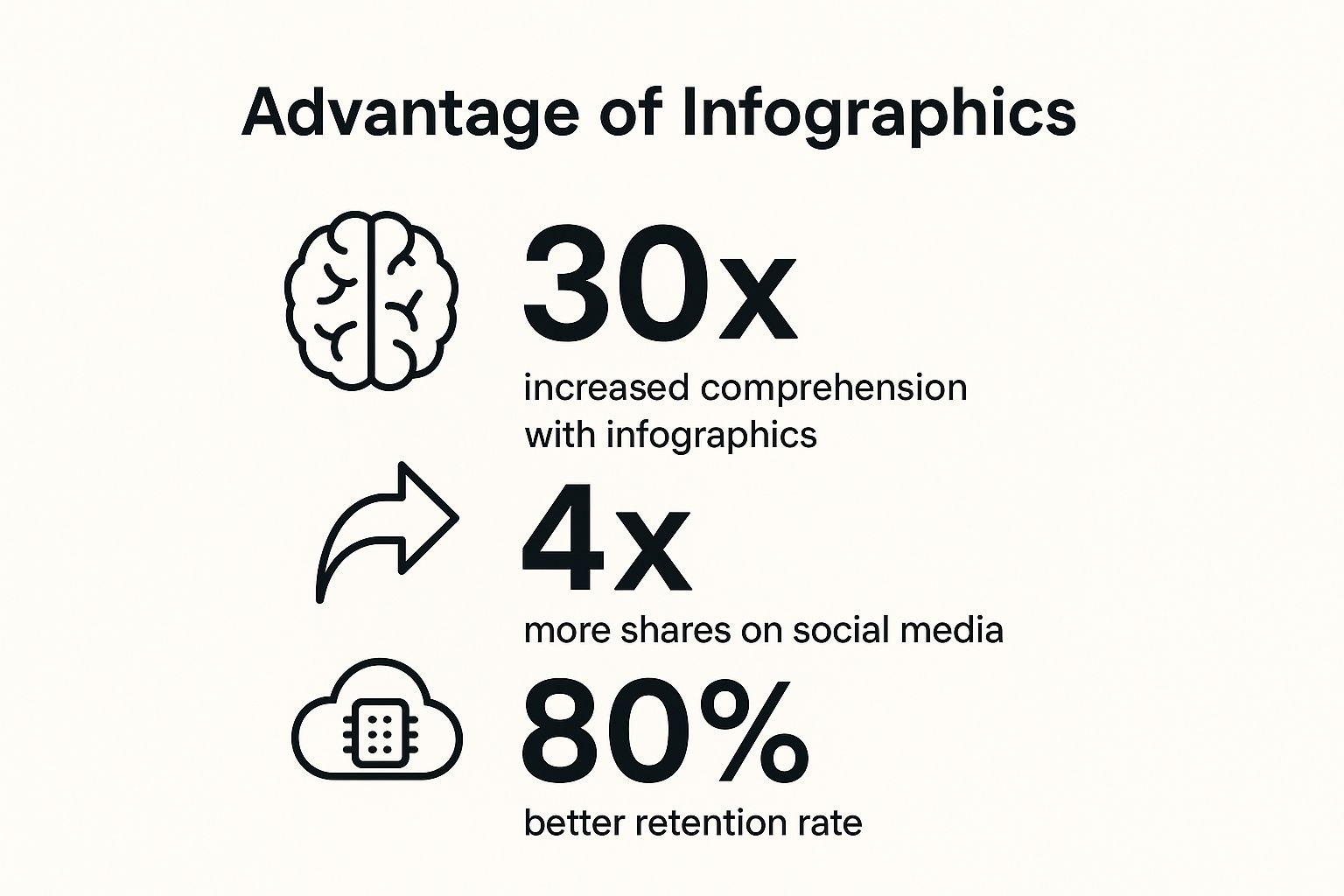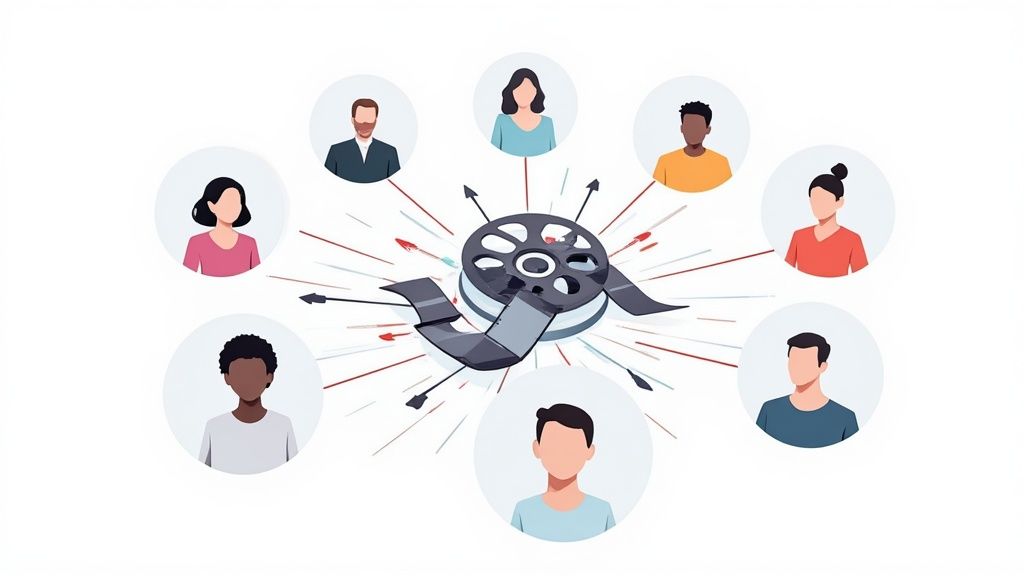Top Visual Storytelling Examples to Inspire Your 2025 Projects



In a world saturated with content, simply showing isn't enough; you need to tell a compelling story. Visual storytelling is the art and science of using images, video, and design to convey a narrative, evoke emotion, and drive action. It transforms abstract data and complex ideas into memorable experiences that resonate deeply with audiences. The difference between a forgotten ad and a legendary campaign often lies in its ability to weave a powerful visual tale. This article will dissect seven outstanding visual storytelling examples across different media, from infographics to brand identity.
This is not a gallery of pretty pictures. Instead, it's a strategic breakdown designed for action. We will move beyond surface-level praise to analyze the specific tactics, creative decisions, and replicable methods behind each success. You will learn not just what these creators did, but how their strategies work and why they are so effective. Before diving into specific visual mediums, it's crucial to grasp the fundamental essence of narrative structure. For a comprehensive guide, consider exploring resources on understanding the core principles of storytelling.
Each example is a masterclass in communication, demonstrating how to:
- Turn complex data into clear, persuasive infographics.
- Build immersive narratives through interactive web design.
- Use video to forge deep emotional connections.
- Leverage sequential art for engaging social media content.
Prepare to deconstruct what makes these visual stories stick. By the end, you'll have a toolkit of proven techniques to apply directly to your own marketing, branding, and communication efforts, helping you craft narratives that not only capture attention but also drive meaningful results.
1. Data Storytelling with Infographics
Data storytelling through infographics transforms complex, raw data into a compelling and digestible narrative. This approach marries statistical information with intentional design, making dense figures accessible, memorable, and shareable. Instead of just presenting numbers, it weaves them into a story that guides the audience to a specific conclusion, making it one of the most effective visual storytelling examples for educating or persuading an audience.
This method works by establishing a clear narrative arc first. A strong infographic identifies the core message, introduces the supporting data points sequentially, and culminates in a clear takeaway. This structure helps audiences connect with the information on an emotional and intellectual level, turning a potentially dry spreadsheet into an engaging experience.
Strategic Analysis: Spotify Wrapped
A masterful example is Spotify's annual "Wrapped" campaign. Each year, Spotify provides users with a personalized, shareable story of their listening habits. It doesn't just list top songs; it creates a narrative around the user's year in music, using vibrant branding, dynamic animations, and bite-sized data points.
- Personalization as Narrative: The story is inherently personal, focusing on "you." This creates immediate emotional investment.
- Sequential Reveal: Data is presented in a specific order, like a story unfolding. It starts with genres, moves to top artists and songs, and often includes unique metrics like "listening personality."
- Shareability by Design: The entire experience is optimized for social media. Each data point is a visually distinct card, encouraging users to post their story and compare with friends, generating massive organic reach.
Key Insight: Spotify Wrapped succeeds because it doesn't just visualize data; it frames it as a personal identity statement. The visual story becomes a badge of honor that users are proud to share, turning individual data into a global cultural event.
Actionable Takeaways and Best Practices
To leverage data storytelling effectively, focus on clarity, narrative, and design. The power of this format is shown in the following infographic, which highlights key statistics on the impact of using visual data.

These metrics underscore why infographics are a strategic tool: they significantly boost comprehension, retention, and social engagement.
Here are specific tactics to replicate this success:
- Start with a Single Question: Before designing, define the one question your data answers. This will be the central theme of your narrative. For example, Google's "Year in Search" answers the question, "What did the world care about this year?"
- Use a Visual Hierarchy: Guide the viewer's eye. Use size, color, and placement to emphasize the most important data point first, then lead them through the supporting details.
- Prioritize Credibility: Always cite your data sources clearly and prominently. This builds trust and positions your brand as an authority.
- Optimize for All Platforms: Design with a mobile-first mindset. Ensure text is legible and visuals are clear on small screens. Test how your infographic looks when shared on social media feeds.
2. Interactive Web Storytelling
Interactive web storytelling transforms passive consumption into an active, immersive experience. By integrating user actions like scrolling, clicking, and hovering directly into the narrative flow, this format gives the audience agency, allowing them to uncover the story at their own pace. It blends text, video, audio, and animation into a cohesive digital journey, making it one of the most powerful visual storytelling examples for creating deep user engagement and emotional connection.
This method excels by treating the web page not as a static document but as a dynamic canvas. The story unfolds in response to user input, making each interaction a meaningful part of the narrative reveal. This participatory approach captures attention far more effectively than traditional articles, turning a simple visit into a memorable, hands-on exploration.

Strategic Analysis: The New York Times' "Snow Fall"
A landmark example that pioneered this format is The New York Times' "Snow Fall: The Avalanche at Tunnel Creek." This Pulitzer Prize-winning piece seamlessly combined long-form journalism with high-resolution video, animated graphics, and parallax scrolling effects. As users scrolled, the story of the deadly avalanche unfolded through interviews, 3D mountain models, and survivor accounts that appeared dynamically.
- Environmental Immersion: Parallax scrolling created a sense of depth and movement, making readers feel like they were descending the mountain alongside the skiers.
- Controlled Narrative Pacing: Key information, witness videos, and animations were triggered at specific scroll points, ensuring the reader absorbed critical context before moving on.
- Multimedia Synergy: Video and text were not separate elements; they were interwoven. A video would play to illustrate a point made in the text, creating a single, powerful narrative experience.
Key Insight: "Snow Fall" proved that digital journalism could be as cinematic and immersive as a documentary film. It succeeded by using interaction not as a gimmick but as a tool to deepen understanding and emotional impact, setting a new standard for online storytelling.
Actionable Takeaways and Best Practices
To build compelling interactive stories, the user experience must be flawless and intuitive. The interactions should serve the narrative, not overshadow it. The following video from The Pudding, a studio renowned for visual essays, demonstrates how complex data and stories can be made interactive and accessible.
These immersive experiences build brand authority and keep users engaged for significantly longer periods.
Here are specific tactics to replicate this success:
- Prioritize a Strong Narrative Core: Your technology and interactive elements must always serve the story. Start with a compelling narrative arc and then identify moments where interaction can enhance it.
- Use Interactions to Enhance, Not Distract: An interaction should reveal information or create an emotional effect. Avoid adding clicks or animations just for the sake of it. For example, use a scroll-triggered animation to show a process unfolding over time.
- Ensure Technical Performance: Slow loading times kill immersion. Optimize all assets, especially images and videos, for fast performance. Test rigorously across multiple browsers, devices, and connection speeds.
- Design with Accessibility in Mind: A great story should be accessible to everyone. Ensure your design works for users with disabilities by following WCAG standards, providing text alternatives for visuals, and ensuring keyboard navigation is possible.
3. Video Storytelling and Documentaries
Video storytelling uses moving images, sound, and narrative structure to forge powerful emotional connections. This format, which ranges from short, viral social media clips to feature-length documentaries, leverages cinematic techniques to immerse an audience in a story. By combining visuals, audio, and pacing, video can convey complex emotions and messages with an immediacy that other mediums struggle to match, making it a cornerstone among visual storytelling examples.
This method is uniquely effective because it engages multiple senses simultaneously. A well-crafted video guides the viewer through a narrative arc with a clear beginning, middle, and end, often using authentic human stories to build empathy and trust. This multi-sensory, narrative-driven experience makes the core message not just understood, but felt.
Strategic Analysis: Patagonia's "Worn Wear"
A standout example is Patagonia's "Worn Wear" campaign and its associated short-form documentaries. Instead of a traditional product ad, the campaign tells stories of real customers and their long-loved Patagonia gear, celebrating durability and the adventures the clothing has enabled. It reframes consumption as a long-term relationship with a product.
- Authenticity as a Brand Pillar: The stories feature real people, not actors, sharing genuine memories. This authenticity builds immense trust and reinforces Patagonia's commitment to quality and sustainability.
- Narrative Over Product: The focus is on the human experience, the journeys, and the memories associated with the garment. The product is a supporting character in the customer's life story, not the hero.
- Mission-Driven Content: The campaign directly supports Patagonia's core mission to "save our home planet" by promoting repair and reuse over replacement. This turns a simple purchase into an act of environmentalism.
Key Insight: Patagonia succeeds by selling a philosophy, not just a jacket. The video stories transform customers into advocates for a sustainable lifestyle, creating a community bound by shared values and proving that brand loyalty can be built on purpose.
Actionable Takeaways and Best Practices
To harness the power of video storytelling, focus on authentic narratives that align with your brand's core mission. Videos, especially animated ones, can simplify complex ideas into engaging formats. If you're considering this approach, you can explore the benefits of 2D explainer videos for your own marketing campaigns.
These strategies are not just for large brands; they can be adapted for any scale. The key is to connect emotionally before you try to sell.
Here are specific tactics to replicate this success:
- Hook Within 5 Seconds: Capture attention immediately. Start with a compelling visual, a provocative question, or an emotional moment to prevent viewers from scrolling past.
- Prioritize Authentic Stories: Whenever possible, feature real people, employees, or customers. Their unscripted emotions and genuine experiences are more persuasive than any polished ad copy.
- Optimize for the Platform: Tailor the video's length and format. A 15-second vertical video works for Instagram Stories, while a 3-5 minute documentary-style piece is better for YouTube or your website. Always include captions for accessibility and silent viewing.
- Plan for Multiple Formats: Shoot and edit with versatility in mind. From one long-form video, you can create dozens of assets: short clips, GIFs, quote graphics, and audio snippets for different channels.
4. Comic Strip and Sequential Art Storytelling

Comic strip storytelling uses sequential art, a series of illustrated panels, to build a narrative that guides readers through time, action, and emotion. This format brilliantly simplifies complex information, blending illustration and minimal text to make difficult or dry subjects accessible and deeply engaging. By breaking a story into digestible frames, it controls the pacing and focuses the audience's attention, making it one of the most human-centric visual storytelling examples for education and brand communication.
This method works because it leverages our natural ability to process sequential images and infer the actions happening between panels, a concept known as "closure." The structured flow of a comic strip creates an intuitive reading experience, allowing brands to explain processes, policies, or technical concepts without overwhelming the audience. Its inherent blend of art and narrative can evoke emotion, add humor, and build a strong connection with the reader.
Strategic Analysis: Google's Privacy Policy Comic
A powerful example of this format in a corporate context is Google's comic explaining its Chrome browser privacy policy. Instead of publishing a dense legal document that few would read, Google collaborated with comic artist Scott McCloud to create a clear, engaging, and surprisingly readable guide.
- Simplifying Complexity: The comic translates abstract technical concepts like sandboxing, malware protection, and data handling into simple visual metaphors that anyone can understand.
- Building Trust through Transparency: By taking the effort to explain its policies in an accessible format, Google appears more transparent and user-focused, proactively addressing user concerns.
- Narrative Flow: The comic uses a consistent guide character to walk the reader through each feature. This narrative structure makes the information feel less like a policy and more like a helpful tour.
Key Insight: Google transformed a mandatory, often-ignored legal document into a piece of effective marketing content. It used sequential art not just to inform but to build goodwill and demonstrate a commitment to user understanding, proving that even the driest subject matter can be brought to life with the right visual narrative.
Actionable Takeaways and Best Practices
To effectively use comic strips and sequential art, focus on clarity, visual consistency, and narrative purpose. The format is ideal for breaking down step-by-step processes, explaining abstract ideas, or telling a short, impactful brand story.
Here are specific tactics to replicate this success:
- Establish a Clear Visual Language: Use a consistent style for characters, backgrounds, and color palettes. This ensures the comic is easy to follow and reinforces your brand's visual identity. IKEA’s wordless assembly instructions are a global masterclass in this, using consistent design to transcend language barriers.
- Balance Text and Visuals: Let the images do most of the heavy lifting. Keep text concise and place it strategically within panels so it doesn't disrupt the visual flow. The best comics show, they don't just tell.
- Mind the Gutter: The space between panels (the "gutter") is where the reader's imagination fills in the gaps. Pace your story by carefully considering what action you show versus what you imply between frames.
- Use Humor Strategically: Humor can make your message more memorable and shareable, as proven by creators like The Oatmeal (Matthew Inman). Ensure it aligns with your brand voice and is appropriate for the topic and audience.
5. Social Media Visual Storytelling
Social media visual storytelling adapts complex narratives for platform-specific formats like Instagram Stories, TikTok videos, and Twitter threads. This approach prioritizes ephemeral, bite-sized, and highly engaging content designed to capture attention quickly and encourage immediate interaction, such as shares, comments, and saves. By leveraging the unique features of each platform, it transforms passive scrolling into an active, participatory experience, making it one of the most dynamic visual storytelling examples for building a loyal community.
This method thrives on authenticity and immediacy. Instead of a single, polished narrative, it often involves a continuous stream of content that collectively builds a brand's personality and story over time. The goal is to create a direct and relatable connection with the audience, making them feel like part of an ongoing conversation rather than just consumers of marketing material.

Strategic Analysis: Wendy's on Twitter (X)
A prime example of this strategy is the persona Wendy's has cultivated on Twitter (now X). The brand moved beyond simple promotional posts and adopted a witty, sarcastic, and highly interactive voice, supported by custom visuals like memes and GIFs. This approach turned a fast-food chain's social media account into a must-follow source of entertainment.
- Personality as the Plot: The core narrative isn't about burgers; it's about the "Wendy's" character. This consistent personality drives engagement because users know what to expect and look forward to the brand's next clever retort or roast.
- Reactive and Real-Time Content: Wendy's excels at real-time marketing, jumping into trending conversations and interacting directly with users and other brands. This makes their content feel current and relevant, fostering a sense of community.
- Visuals as Punchlines: The brand uses simple, often low-fi graphics and memes to deliver comedic punchlines. This visual language is native to the platform, making the content feel organic rather than corporate.
Key Insight: Wendy's success demonstrates that on social media, brand personality can be the most compelling story of all. By prioritizing entertainment and authentic interaction over direct selling, they built a massive following that willingly amplifies their marketing messages.
Actionable Takeaways and Best Practices
To succeed with social media storytelling, brands must embrace the native culture of each platform while maintaining a consistent identity. This requires a deep understanding of what resonates with specific online communities and a willingness to experiment. By transforming your feed into a source of value, whether through education, entertainment, or inspiration, you can build a powerful brand asset. For more inspiration, explore a variety of content marketing ideas on moonb.io that can be adapted for social platforms.
Here are specific tactics to replicate this success:
- Define Your Brand Persona: Before posting, establish a clear voice and personality. Is your brand witty, helpful, inspiring, or authoritative? Document this and ensure all content aligns with it.
- Master Platform-Specific Features: Don't just cross-post. Use Instagram Reels for short-form video trends, Twitter threads for micro-blogging, and TikTok for culturally relevant audio and effects.
- Encourage User-Generated Content (UGC): Create prompts, contests, or branded hashtags that invite your audience to share their own stories related to your brand. Feature the best submissions to build community and trust.
- Engage, Don't Just Broadcast: Actively respond to comments, messages, and mentions. Ask questions in your captions and create polls or quizzes in Stories to foster a two-way conversation.
6. Presentation and Slide Storytelling
Presentation storytelling elevates a standard slide deck from a simple series of informational points into a cohesive and persuasive visual journey. This method rejects text-heavy, bullet-point-driven slides in favor of a narrative structure supported by powerful imagery, intentional pacing, and minimalist design. By treating a presentation as a story, speakers can connect with their audience emotionally, making complex ideas more understandable, memorable, and impactful.
This approach works by establishing a clear narrative arc, much like a film. It has a beginning (the setup or problem), a middle (the confrontation or solution), and an end (the resolution or call to action). Each slide serves as a scene, advancing the story one beat at a time. This makes it one of the most powerful visual storytelling examples for winning over investors, launching products, or inspiring action.
Strategic Analysis: Airbnb's Original Pitch Deck
A legendary example of this technique is Airbnb's original 2008 pitch deck, which helped them secure crucial early funding. The deck is celebrated for its simplicity and brilliant narrative structure, boiling down a complex business idea into a story that any investor could immediately grasp.
- Problem-Agitator Structure: The deck opens by framing a clear, relatable problem for two distinct groups: travelers wanting affordable lodging and hosts wanting to earn money. It presents the problem, then agitates it by showing the poor existing solutions.
- Hero's Journey Narrative: Airbnb presents its platform as the hero of the story. The slides sequentially introduce the solution, show how it works (Product), validate the market (Market Size), and outline the path to victory (Business Model).
- Visual Simplicity: The slides are incredibly clean, often featuring a single, bold headline and a simple image or a few key numbers. This visual minimalism forces the audience to listen to the presenter rather than read the slides, keeping the focus on the story being told.
Key Insight: Airbnb's pitch deck succeeded because it sold a vision, not just a service. The visual story wasn't about features; it was about connecting people and solving a universal problem. It made the abstract concept of renting a room in a stranger's house feel simple, safe, and inevitable.
Actionable Takeaways and Best Practices
To transform your presentations into compelling visual stories, focus on narrative flow and visual clarity. This approach is fundamental to creating an effective software demo presentation, where guiding the user through a story is key to adoption.
Here are specific tactics to replicate this success:
- Embrace the 10/20/30 Rule: Popularized by Guy Kawasaki, this rule is a great starting point: a presentation should have 10 slides, last no more than 20 minutes, and contain no font smaller than 30 points. This forces you to be concise and focus on the core message.
- One Idea Per Slide: Resist the urge to cram multiple points onto a single slide. Dedicate each slide to one central idea, supported by a strong visual. This creates a clear, rhythmic pace that keeps the audience engaged.
- Create a "Visual Theme": Use a consistent color palette, typography, and style of imagery throughout the deck. This professional polish builds credibility and makes the narrative feel cohesive, similar to the branding in Apple's iconic keynotes.
- Design for the Back Row: Ensure your visuals and text are large and clear enough to be understood from the furthest point in the room. If it can't be read easily, it shouldn't be on the slide.
7. Brand Identity and Logo Storytelling
Brand identity and logo storytelling use a cohesive system of visual elements, including logos, color palettes, typography, and imagery, to communicate a brand's core values, personality, and overarching narrative. This method creates a silent yet powerful dialogue with the audience, embedding the brand’s story into every touchpoint. Instead of just being a recognizable mark, a logo and its surrounding identity become a vessel for meaning, making this one of the most foundational visual storytelling examples for building long-term equity.
This approach works by translating abstract brand concepts into a tangible visual language. A well-designed brand identity ensures that every interaction, from a business card to a billboard, consistently reinforces the same story. This visual repetition builds familiarity and trust, allowing a brand to convey its mission and promise without saying a word, creating an instant connection with its audience.
Strategic Analysis: Patagonia
Patagonia’s brand identity is a masterclass in visual storytelling that aligns perfectly with its mission. The brand doesn't just sell outdoor apparel; it sells a philosophy of environmental stewardship and rugged adventure, and its visual language is the primary storyteller. The iconic logo, featuring the Fitz Roy mountain range, immediately evokes a sense of wildness and challenge.
- Logo as a Mission Statement: The logo isn't just a mountain; it’s a specific, revered peak that represents the spirit of untamed nature Patagonia vows to protect. This grounds the brand in a real, physical place tied to its values.
- Consistent Visual Language: From its earthy color palette to its utilitarian typography and photography featuring real people in harsh environments, every element reinforces authenticity, durability, and a deep respect for the outdoors.
- Action-Oriented Imagery: Patagonia’s visuals rarely feature pristine, posed models. Instead, they show gear in action, often weathered and used, telling a story of adventure, resilience, and products built to last, not to be discarded.
Key Insight: Patagonia's visual identity succeeds because it is an authentic reflection of its core mission. The story isn't just a marketing layer; it's embedded in the company's DNA, and the visuals serve as credible proof, turning customers into advocates for the brand's cause.
Actionable Takeaways and Best Practices
To build a powerful brand identity story, you must achieve deep alignment between your visuals and your values. The story must be authentic and consistently applied across all channels. If you want to dive deeper into how brands tell their stories, you can learn more about brand story examples on moonb.io.
To understand how brand identity can be strategically evolved to tell a new story, you might find inspiration from real-world successful brand transformations. There are many iconic rebranding examples that show how a visual refresh can redefine a company's narrative for a new era.
Here are specific tactics to replicate this success:
- Define Your Core Narrative First: Before any design work begins, articulate your brand's purpose, values, and personality in a clear, concise statement. This narrative will be the strategic foundation for all visual decisions.
- Create Comprehensive Brand Guidelines: Document your logo usage, color codes, typography rules, and imagery style in a detailed brand book. This ensures consistency across all teams and touchpoints, reinforcing your story everywhere.
- Choose Colors with Intention: Every color evokes specific emotions and associations. Select a palette that aligns with the story you want to tell. For instance, blues often convey trust and stability, while greens can suggest nature and growth.
- Prioritize Flexibility for the Future: While consistency is key, design an identity system that can evolve. Consider how your logo and visual elements will adapt to new products, digital platforms, and future market shifts.
Visual Storytelling Methods Comparison
Unlocking Your Brand's Visual Narrative
Throughout this exploration of visual storytelling examples, a powerful, unifying thread emerges: stories, when told visually, possess an unparalleled ability to cut through the noise, forge deep connections, and drive meaningful action. We’ve journeyed from the data-driven clarity of infographics and the immersive potential of interactive web experiences to the raw, human emotion of documentary-style video. The common denominator in every successful case study is not a colossal budget or a massive team, but a foundation built on strategic intent.
Each impactful visual narrative began with a precise understanding of its audience, a clearly defined objective, and a story meticulously tailored to its chosen medium. This strategic approach is the great equalizer, empowering brands of all sizes to create work that resonates. The principles are universal, whether you're mapping out a complex process with sequential art or building an entire brand identity from a single, powerful logo.
From Examples to Execution: Your Strategic Blueprint
The diverse visual storytelling examples we've analyzed offer more than just inspiration; they provide a repeatable blueprint for success. Moving forward, the goal is to translate these insights into a tangible strategy for your own brand. Don't view these case studies as isolated successes, but as a toolkit of proven methods.
Your path forward can be distilled into three core, actionable pillars:
- Audience-Centric Storytelling: Always start with who you are talking to. What are their pain points, aspirations, and communication preferences? A comic strip might resonate with a tech-savvy startup audience, while a formal, data-rich presentation is better suited for enterprise stakeholders. The story is only effective if it speaks their language.
- Medium-Message Alignment: The medium is a crucial part of the message. A complex dataset that feels overwhelming in a paragraph can become an intuitive story in an infographic. A brand's origin story, flat on an "About Us" page, can become an emotional journey in a short video. Choose your format not based on trends, but on what will best serve the narrative you need to tell.
- Strategic Brand Consistency: Every visual asset you create is a chapter in your brand's larger story. From the color palette of your social media graphics to the typography on your website, consistency builds trust and recognition. To understand how brand identity can be visually communicated cohesively across different assets, a case study like the one developed for Board of Innovation's visual narrative provides excellent insight into creating a unified and memorable presence.
The True Value of Visual Mastery
Mastering visual communication is no longer a "nice-to-have" for marketing and creative leaders; it is a fundamental driver of business growth. In a crowded digital landscape, a compelling visual story is your best tool for capturing attention, simplifying complexity, and building a loyal community around your brand. It transforms abstract ideas into concrete, memorable experiences.
The power of these visual storytelling examples lies in their demonstration that with the right strategy, any brand can connect on a more human level. By embracing these techniques, you move beyond simply showing what you do and begin to articulate why it matters. This is the key to creating a brand that people not only remember but actively choose to champion. Let these examples be the catalyst that transforms your brand's communication from merely informational to truly inspirational.
Ready to turn these insights into high-impact visual content for your brand? Moonb offers an on-demand, flexible creative subscription, giving you access to a full team of designers, animators, and strategists. Start transforming your ideas into compelling visual narratives today with Moonb.






